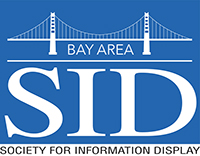Archives 2024
March 13, 2024
UV Pumped, Quantum Dot Color Conversion Micro-LED Displays Manufacturing Readiness
Dr. Nag Patibandla, Vice President, Advanced Deposition Products, Office of the CTO at Applied Materials, Inc
Presentation Abstract
Applied Materials, Inc has developed a novel micro-LED display architecture together with commercial-scale process and equipment for micro-LED display manufacturing. This architecture consists of UV-A micro-LEDs, 4-subpixel layout, Cd-free QD formulations (of all three primary colors R/G/B), and a UV blocker atop. Several 1.37” smart-watch active-matrix display prototypes were assembled and tested. Our Cd-free QDs and the matrix materials are quite stable under the UV excitation used in our display, as verified by exposing them to display operation conditions but also under a high-flux accelerated test method and temperature. The emission properties of R/G/B QDs were further optimized, paving a path to achieve 100% DCI-P3 color space coverage. Our display also shows a high uniform Lambertian emission pattern with minimal color shift at all viewing angles. We have developed a production scalable micro-LED die transfer processes and corresponding equipment using which we have achieved > Four 9s transfer yields. To precisely deposit and massively process R/G/B QD inks into respective sub-pixel well array of our display, we have developed a production-scale process and print-platform details of which will be highlighted in the presentation. To address pixel-yield loss from die-transfer, we have implemented a simplified sub-pixel repair method that allows for ink-jetting of QD formulation into defective subpixel. This approach results in over a 10-fold yield improvement. In this presentation, we will report the readiness of key processes, materials, and equipment scalable towards commercialization.
Dr. Nag Patibandla, Vice President, Advanced Deposition Products, Office of the CTO at Applied Materials, Inc

Nag Patibandla is the Vice President for Advanced Deposition Products in the Office of the CTO at Applied Materials, Inc. He manages a number of emerging technology programs aimed at developing new products, validating innovation, defining product architecture and business strategy, and engaging partners. Nag’s current areas of interest include: Micro-LED displays, III-Nitride devices, superconducting materials, optical and quantum films, 3D Printing, CMP pads, deposition processes (MOCVD, PVD), etc. His expertise is in identifying growth opportunities and developing strategic plans for product development in various emerging technologies and semiconductor-adjacent areas. In addition,
Nag oversees Applied’s government/external funding strategy, development, and programs in various core and adjacent areas of business.Nag joined Applied in 2008. Since, he has helped establish programs in various new technology areas and has established an infrastructure to secure and administer external/government funding for growth programs. Nag has over 25 years of experience in industry, academia, and government, with an extensive R&D background in semiconductors, solid state lighting, photovoltaics, batteries, fuel cells, high temperature superconductivity, and related technologies. Before joining Applied, Nag was the Director of Center of Future Energy Systems at Rensselaer Polytechnic in Troy, NY. Prior to that, he worked in New York State government and at the General Electric Global R&D Center.
Nag received his Ph.D. in Materials Science and Engineering and a Master’s degree in Mechanics and Materials Science from Rutgers University, NJ, having first completed his bachelor’s degree in Metallurgical Engineering at the National Institute of Technology, Warangal (formerly Regional Engineering College) in India. He has authored/co-authored over 300 publications that include peer reviewed papers and patent applications in various areas of materials engineering.
In recognition of his professional achievements, the Board of Governors and Management of National Institute of Technology, Warangal, India bestowed Distinguished Alumni Professional Achievement Award (2020). Other notable recognitions include CHP Champion by the U.S. Combined Heat and Power Association (2003), Energy Professional of the Year by the New York Chapter of Association of Energy Engineers (2007), Rensselaer Polytechnic Institute Trustee “Faculty Achievement” recognition (2007), Applied Materials President’s Quality Award (2011) and the Best Patents of Applied Materials award (2018). Dr. Patibandla currently serves a four-year term as a Member of Emerging Technology Technical Advisory Committee, U.S. Dept of Commerce (2020-24), and had previously served on numerous U.S. Dept. of Energy Committees and various U.S. National Laboratory External Review Panels.
February 13, 2024
Enabling AI Glasses Through Single Panel RGB Micro-LED
Dr. Nikhil Balram CEO at Mojo Vision
Presentation Abstract
Science-fiction writers have long imagined a world in which omniscient AI lives at our fingertips guiding and informing our every move. The astounding advances made in 2023 have brought that day closer. But a big practical barrier is developing the device it could most naturally reside on. Having it on your phone seems like a natural step, but what about all those times your phone is in your pocket or purse or car cupholder. For AI to truly see what you see it needs the same vantage point. And to help you interpret and interact with the world as you see it, it needs to be able to overlay its perspective on top of the one you see. If that sounds like a cool lightweight pair of very #smartglasses to you, you’re right on the money. But all the smart glasses today that look and feel like glasses have camera and audio only. What’s missing! A super-compact, super-efficient display with a super dynamic range and a super colour gamut. Sounds like a cue for micro-LED ![]() . At Mojo we have been building the world’s tiniest displays for several years. First tiny green, then tiny blue, then tiny red. And now tiny red, green, and blue all together as a giant step towards those Eye of God glasses. This talk will walk you through our journey. The world’s smallest Red, Green and Blue displays will be demonstrated to people who attend in person.
. At Mojo we have been building the world’s tiniest displays for several years. First tiny green, then tiny blue, then tiny red. And now tiny red, green, and blue all together as a giant step towards those Eye of God glasses. This talk will walk you through our journey. The world’s smallest Red, Green and Blue displays will be demonstrated to people who attend in person.
Dr. Nikhil Balram - CEO at Mojo Vision

Dr. Nikhil Balram has over 30 years of experience in the semiconductor and display industries. He is currently CEO of Mojo Vision, a Silicon Valley start-up developing micro-LED displays. Past executive roles include CEO of EyeWay Vision Inc., a start-up developing immersive AR glasses, Head of the Display Group at Google, responsible for developing display systems for all Google consumer hardware, including AR and VR, CEO of Ricoh Innovations Corporation, VP and GM of Digital Entertainment BU at Marvell and CTO of the Display Group at National Semiconductor. He has received numerous awards including the Otto Schade Prize from the Society for Information Display (SID) and a Gold Stevie® Award for Executive of the Year in the Electronics category and has over 130 US and international patents granted or pending. Dr. Balram is a Fellow of the SID and was General Chair for Display Week 2021 and Program Chair for Display Week 2019. Dr. Balram received his B.S., M.S. and Ph.D. in electrical engineering from Carnegie Mellon University.
January 24, 2024
The role of Perceptual Imaging in AR/VR/XR
Ajit Ninan, Sr. Director at Meta
Presentation Abstract
Ajit Ninan
 Ajit Ninan recently joined Meta as Sr. Director leading the APIX team that works on display architecture, perception, and image quality. Prior to this he was at Dolby as VP of imaging in the advance technology group, working on HDR and Dolby Vision. He is best known for building "Pulsar” a first of a kind 4000nit WCG HDR display. "Pulsar" is recognized as the key that drove Hollywood to adopting HDR and is still the monitor used for color grading in the movie industry. He is the inventor of the local dimming Quantum Dot TV, after being told there was no way to build a wide color HDR display his team built “Maui” that received the ‘2014 Best in Show SID’ for a first ever local dimmed Quantum dot display. This became the reference monitor for the industry and was the starting point for QD TV tech in the industry. To bring this together at Dolby he led display system teams consisting of Vision Science, Color science, Optics, Mechanical, SW, Thermal, Electrical, FPGA/ASIC & Laser scientists.
Ajit Ninan recently joined Meta as Sr. Director leading the APIX team that works on display architecture, perception, and image quality. Prior to this he was at Dolby as VP of imaging in the advance technology group, working on HDR and Dolby Vision. He is best known for building "Pulsar” a first of a kind 4000nit WCG HDR display. "Pulsar" is recognized as the key that drove Hollywood to adopting HDR and is still the monitor used for color grading in the movie industry. He is the inventor of the local dimming Quantum Dot TV, after being told there was no way to build a wide color HDR display his team built “Maui” that received the ‘2014 Best in Show SID’ for a first ever local dimmed Quantum dot display. This became the reference monitor for the industry and was the starting point for QD TV tech in the industry. To bring this together at Dolby he led display system teams consisting of Vision Science, Color science, Optics, Mechanical, SW, Thermal, Electrical, FPGA/ASIC & Laser scientists.
Ajit’s background includes multiple companies from Motorola, Netlogic, and Luminous working on imaging and networking over the last 25+ years. He helped Dolby enter the display and imaging space and was responsible for technologies related to display systems, laser sources for cinema, and HDR ecosystems. In addition to display’s, he has worked on file formats, AR/VR ecosystems and related workflows. He personally holds more than 400+ patents, is a SMPTE Fellow with two Emmy’s and Hollywood’s Advanced Imaging Society’s Lumiere Award for display engineering and changing the way the way the industry builds display. He was actively involved in standards including IEEE, JPEG and SMPTE standards groups. Ninan continues to push the boundaries on display innovation at Meta.
To view past year archives visit: https://www.sid.org/Chapters/Bay-Area/SeminarArchive
